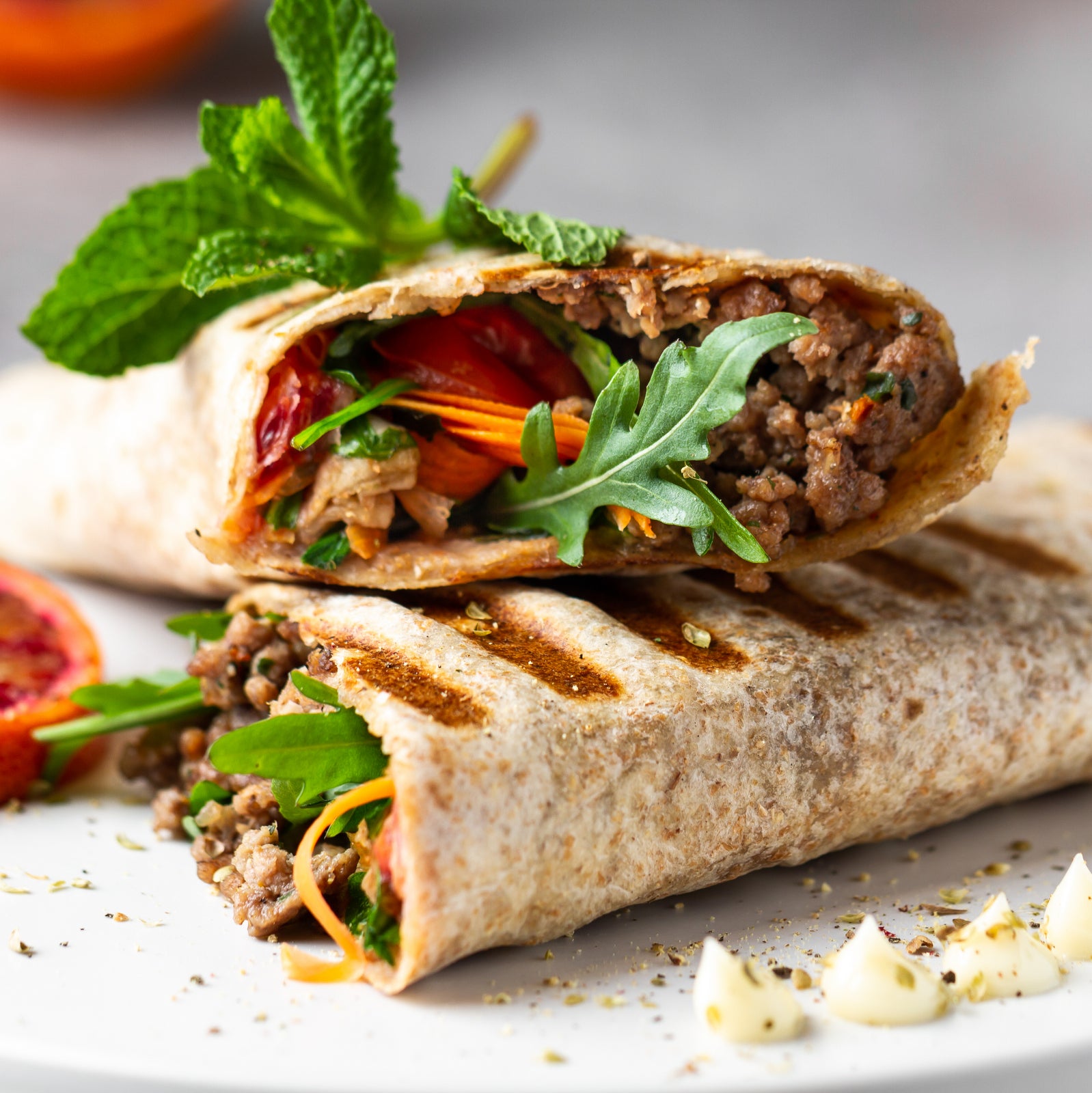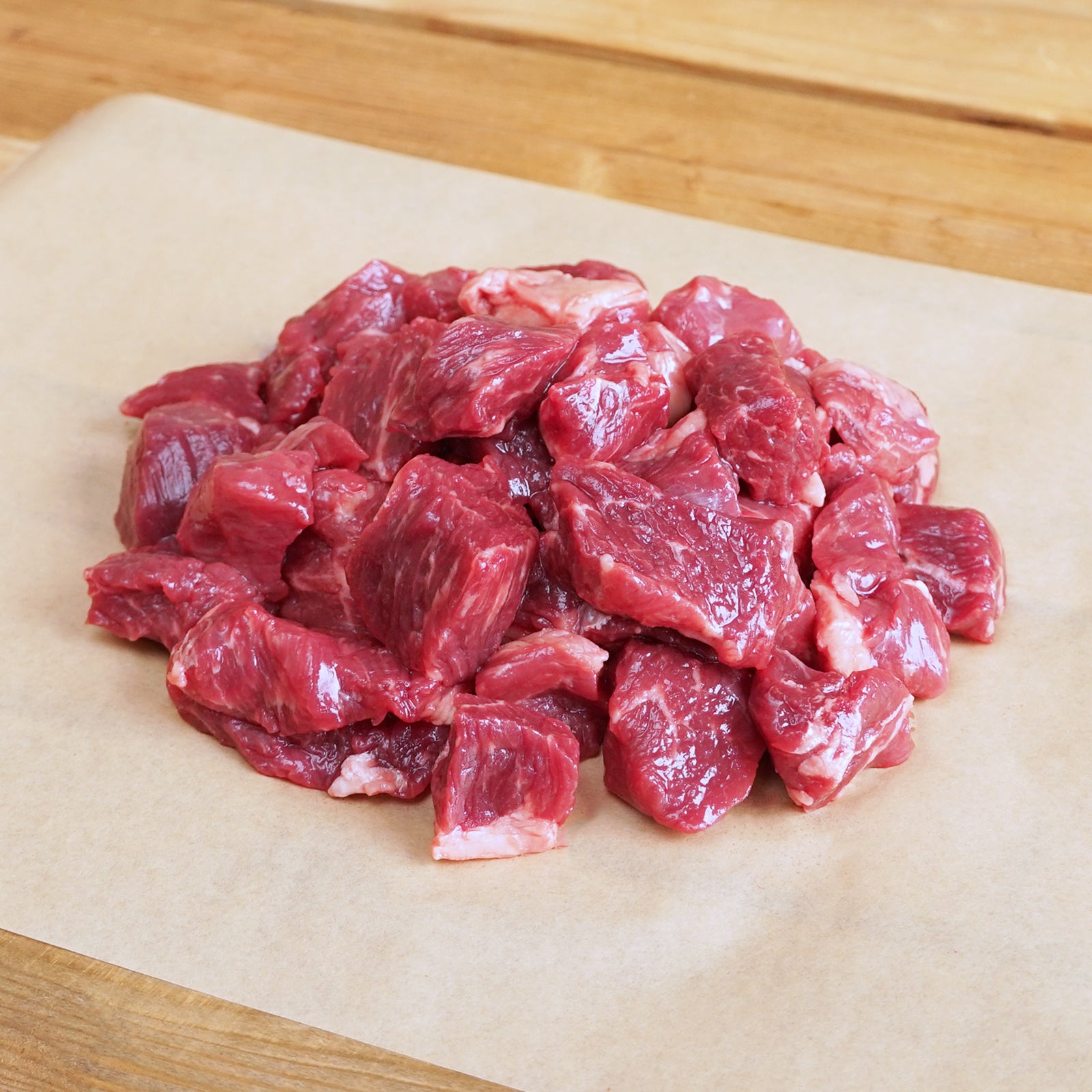What Is Grass-Fed Beef?
When you hear the phrase “grass-fed” you can probably imagine a herd of cattle eating green grass in a lush pasture. Grass types may differ based on the region or climate the cattle is raised in, but generally the cows will be nourished entirely by grass and legumes they find while grazing. Due to the high-quality plants the animals eat, grass-fed beef becomes leaner and less fatty than other beef. Fattier meats can sometimes lead to indigestion, but the leaner grass-fed beef mitigates that problem and allows the meat to be enjoyed more fully. The meat remains full of protein, but with less fat and fewer calories. Because of that, it has become a go-to choice for athletes and other health-conscious consumers.
Differences from Grain-Fed Beef
The other main beef option is grain-fed beef. Grain-fed beef comes from cattle that is fed grains like corn, soybeans, and wheat. Because their feed is high in calories, the animals are able to fatten up quickly. It’s not uncommon for this kind of feed to be used in tandem with growth-promoting hormones. Nevertheless, you can be sure that all grain-fed beef that we sell at Horizon Farms is completely hormone free.
Grain-fed livestock develops a fattier profile with a more tender texture than their grass-fed counterparts. In Japan, grain-fed beef is very common, and it’s safe to say that Japanese people thoroughly enjoy this kind of meat.
Characteristics of an All-Grass Diet
So what is unique about cattle that was raised only on grass? For one, their amount of exercise is different. For the cows to have enough grass to eat, the area they’re living in must be vast. There’s generally no feed prepared for them, so to fill their bellies they have to walk around the pasture finding good patches of grass to eat. Inevitably, this results in them getting abundant exercise allowing them to build lean bodies.
Another difference is the amount of calories in their diet. Grains like corn and soybeans have far more calories than grass, so they also give a lot more energy. All those stored calories make the cattle much more likely to store fat. After all, cows are grazing herbivores, and these grains didn’t originally make up a large portion of their diet. The lower fat content in grass-fed beef means we can rest easy knowing that the more naturally grown beef is a safer, worry-free alternative.
Primary Producers of Grass-Fed Beef
Vast open areas are a necessity for raising grass. On top of that, the amount of precipitation and other weather conditions of the area need to be considered when thinking of the right environment to raise the livestock. The primary producers of grass-fed beef have all these things. Specifically, these places include Australia, New Zealand, and Uruguay. Of these, Japan imports a lot of its grass-fed beef from Australia and New Zealand.
Quality of the Meat
As mentioned above, the primary characteristic of grass-fed beef is that it is leaner than other beef. Because of the lean texture, attributed to the amount of exercise the animals get, the meat itself is generally a bit more firm to bite into. Grass-fed cows grow up with all their nutrients coming from things like grass and hay. Compared with grains like corn, soybeans, and wheat, the nutritional value is lower in calories, but by no means lagging behind other kinds of beef.
The Nutritional Value of Grass-Fed Beef
It’s worth mentioning that grass-fed beef is particularly rich in omega-3 fatty acids. This comes specifically from the grass the animals eat. Omega-3 fatty acids are said to reduce triglycerides and LDL cholesterol levels, improve blood flow leading to an enhanced metabolism, and reduce inflammation. And because our bodies don’t make these fatty acids naturally, it’s important to get them from our diet. Grass-fed beef usually offers 2-5 times more than other kinds of beef.
Speaking of nutrients that our bodies can't create, grass-fed beef is also packed with an indispensable amino acid called tryptophan. Tryptophan is believed to calm the mind and improve the quality of your sleep.
Some other nutrients that can be found in grass-fed beef include carotene, vitamin E, vitamin B, and iron, all things that are originally found in plants. Carotene and vitamin E are antioxidants that are said to slow the aging process and can be effective in preventing diseases such as arteriosclerosis (clogged arteries). Vitamin B helps with recovery from fatigue as well as metabolism, while iron plays a crucial role in preventing anemia and is essential for our bloodstreams.
Grass-Fed Lamb
Lamb isn’t an overly familiar meat in Japan, but it’s actually very popular in Australia. Just like with beef, lamb also comes in a grass-fed variety. As with beef, grass-fed lamb offers a satisfying way to enjoy leaner red meat. According to Ireland’s governmental food agency, Bord Bia, the nutritional value of lamb is about the same as beef, offering rich amounts of omega-3 fatty acids, iron, minerals, vitamin E, and protein.
Grass-Fed Beef’s Preparation and Flavor
Steak
How you want to eat your beef is all up to preference, but we highly recommend a nice, hearty steak. Naturally, a fatty cut like a sirloin can be thoroughly enjoyed without it having an overpowering or greasy taste. Sirloins aren’t the only cuts though, and chuck, ribeye, fillets, or any other cut is sure to have an excellent beefy flavor. Sprinkle some salt and pepper, and cook with unsalted butter or olive oil. Pay close attention to the heat and be careful not to cook it past medium rare.
Block
Grass-fed beef’s delicious flavor can also be enjoyed with a block cut. This pairs great with simmered dishes or barbecue, and is flexible enough to be used in a variety of other ways too.
Conclusion – Why Grass-Fed Beef?
Grass-fed beef comes from free-range cattle raised in a natural environment and eating the grass from that area. The amount of exercise they get makes their bodies lean, and their diet fills them with important nutrients. For these reasons, athletes and health-conscious meat-eaters are paying more and more attention to this meat.
Horizon Farms offers grass-fed beef that is guaranteed free of harmful antibiotics, free of growth hormones, and raised free-range in spacious pastures. Please give it a try and see if it’s right for you.
Disclaimer: Please note that while our explanations are correct, they are simplified for shortness and understanding. We encourage you to do further research on the topic.






















